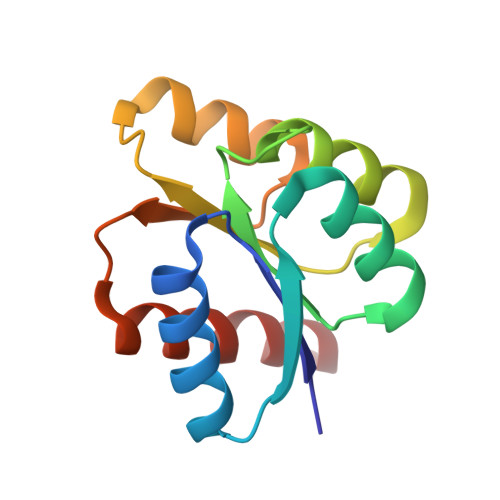Small Molecule Attenuates Bacterial Virulence by Targeting Conserved Response Regulator.
Liu, C., Zhang, H., Peng, X., Blackledge, M.S., Furlani, R.E., Li, H., Su, Z., Melander, R.J., Melander, C., Michalek, S., Wu, H.(2023) mBio 14: e0013723-e0013723
- PubMed: 37074183
- DOI: https://doi.org/10.1128/mbio.00137-23
- Primary Citation of Related Structures:
8FK2 - PubMed Abstract:
Antibiotic tolerance within a biofilm community presents a serious public health challenge. Here, we report the identification of a 2-aminoimidazole derivative that inhibits biofilm formation by two pathogenic Gram-positive bacteria, Streptococcus mutans and Staphylococcus aureus. In S. mutans, the compound binds to VicR, a key response regulator, at the N-terminal receiver domain, and concurrently inhibits expression of vicR and VicR-regulated genes, including the genes that encode the key biofilm matrix producing enzymes, Gtfs. The compound inhibits S. aureus biofilm formation via binding to a Staphylococcal VicR homolog. In addition, the inhibitor effectively attenuates S. mutans virulence in a rat model of dental caries. As the compound targets bacterial biofilms and virulence through a conserved transcriptional factor, it represents a promising new class of anti-infective agents that can be explored to prevent or treat a host of bacterial infections. IMPORTANCE Antibiotic resistance is a major public health issue due to the growing lack of effective anti-infective therapeutics. New alternatives to treat and prevent biofilm-driven microbial infections, which exhibit high tolerance to clinically available antibiotics, are urgently needed. We report the identification of a small molecule that inhibits biofilm formation by two important pathogenic Gram-positive bacteria, Streptococcus mutans and Staphylococcus aureus. The small molecule selectively targets a transcriptional regulator leading to attenuation of a biofilm regulatory cascade and concurrent reduction of bacterial virulence in vivo . As the regulator is highly conserved, the finding has broad implication for the development of antivirulence therapeutics that selectively target biofilms.
- Department of Pediatric Dentistry, University of Alabama at Birmingham Schools of Dentistry and Medicine, Birmingham, Alabama, USA.
Organizational Affiliation:
















